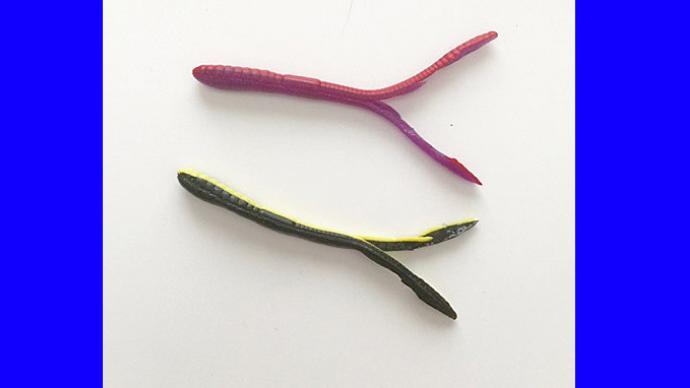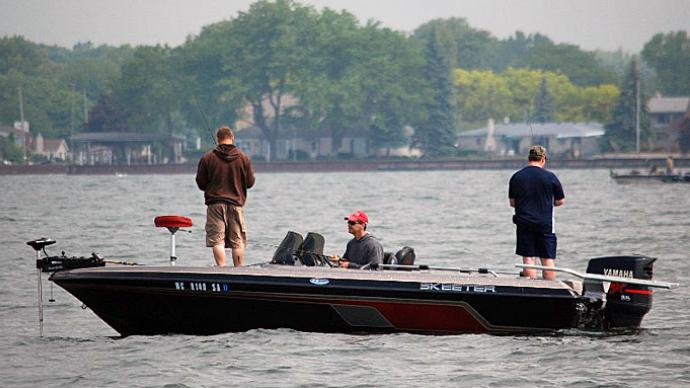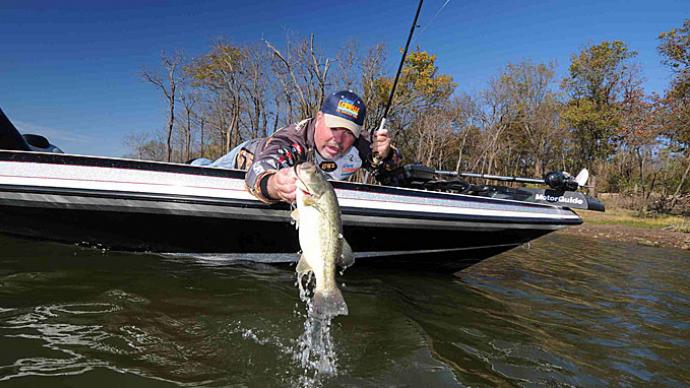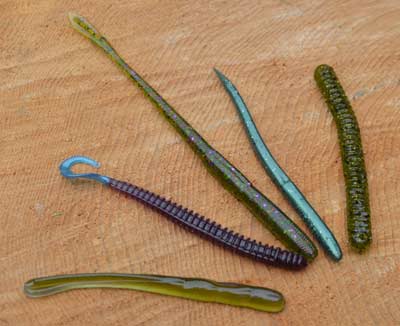
Everyone is ready for change when August rolls around. Summer is dribbling on, and heat and humidity are taking a toll on days on end. That saps motivation, even for bass. And with any real change in conditions more than a month away, easy is the name of the game. While bass often pass on big baits, they eagerly grab a small meal. That puts finesse worms into play.
Finesse worms, with their slender profile and unimposing stature, have always been the go-to remedy for tough fishing. Whether it’s an inordinate amount of fishing pressure or a strong cold front, bass will always bite a small piece of soft plastic. And while finesse worms generate bites from plenty of barely keeper bass, which are welcome under the most challenging conditions or when you're working hard to fill your tournament limit, they score with big bass, too.
While bass bite all finesse worms, each is designed and built slightly differently. They can measure between 3- and 6 inches long and are available in a rainbow's worth of colors. However, the most significant difference between them is found in their tail. Here are the three major types:
- Straight: Probably the most popular version, it’s what Zoom Trick Worms and Roboworms sport. It causes undulations along the worm’s entire length, creating action that defies its simple design.
- Hook: Berkley Powerbait Rib Worm and Mister Twister Phenom use this design. Its flicker gives your presentation a subtle, lifelike touch. Worms with chartreuse or blue tails are perfect panfish imitators.
- Flat: While these worms, such as Strike King Dream Shot or NetBait Crush Worm, are best suited for drop shotting, don’t count out their gliding action on other presentations, especially when casting.
While each design will catch bass in almost any situation, there are better times to use each one. That goes for presentations, too. Deep or shallow, barren bottom or thick cover, or clear or stained water, finding the best finesse worm and presentation for the situation that you're currently fishing in will mean more and bigger bass. Rig your finesse worms these four ways, and you’ll cover all the bases for August bass fishing.
On A Drop Shot
August is primetime for big smallmouth, especially where current washes across deep-water structure. And while more anglers are using forward-facing sonar and soft-plastic minnows impaled on jig heads to target smallmouth suspended over these spots, you’ll still see plenty of action with a drop shot.
A finesse worm is a great bait to drop shot. Its slender profile, especially when poured in a translucent hue and with a straight or flat tail, perfectly matches clear water conditions. If it’s too long, right size it by simply cutting a bit off its nose. And you can rig it two ways: hooked once through the nose for more action or Texas rigged if cover is around.
Vertical is the most popular way to drop shot a finesse worm. The key is keeping your weight on the bottom while leaving some slack in your line. With gentle shakes of your rod tip, which can be created by simply squeezing the grip, move only the line, making your bait dance. Don't hesitate to cast a drop shot. The retrieve is similar, except you pull the weight forward a few feet, then shake your bait. Repeat that process until it's back in your boat.
Tweaking your spinning setup to each of these four presentations makes them more productive. While a 2500 or 3000-size reel sporting a front drag and a gear ratio between 6:1 and 7:1 will cover all of them, each does best with specific components. Here's how to set up for a drop shot:
- Rod: Choose one that measures between 7 and 7-and-a-half feet long. Its medium power has the backbone to control big smallmouth, and its moderate action — flex — will help move your worm.
- Line: Use 5- to 10-pound test braid as your main line. It’s strong and sensitive, transmitting the slightest bite in the deepest water. A few feet of similarly sized fluorocarbon leader adds stealth.
- Hook: Use a No. 1 to 2/0 octopus or drop-shot style hook for nose hooking. Similar-sized offset round bend hooks will handle Texas rigging duties and prevent your worm from sliding down the shank.
- Weight: Keep a variety of sizes — 1/16 to ¾ ounce — on hand to meet changing conditions and locations. Don’t hesitate to use a heavier weight, which simply anchors your rig to the bottom.
On A Jig Head
If you look beyond the drop shot, shaky heads have been the primary means of delivering finesse worms to bass over the past several decades. And that concept — Texas rigging a worm on a jig head — has been around a lot longer. Charlie Brewer, for example, created his Slider approach more than a half-century ago. And it was soon after that the Lindners pushed the combo, though with an exposed hook, during the early days of their In-Fisherman empire.
Image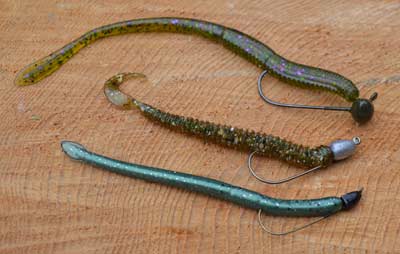
Rig a finesse worm on a Slider-style jig head to reach August bass tucked inside heavy cover such as submerged aquatic vegetation. Swimming it through the plants' tops is the best approach on many days. Photo by Pete M. Anderson Fishing a finesse worm on a jig head brings two benefits. First is its ability to slide through wood, rock, or grass cover. Fishing one lure in multiple spots makes you a more efficient angler. The second is its ability to work at any depth. It works better the deeper it goes, especially when you employ a football-shaped jig head.
Regardless of your worm's tail design, this presentation works on natural lakes, where it can be deployed along deep weed edges, down rocky dropoffs, and through the tops of submerged aquatic vegetation. It also produces in reservoirs, where you can use it to probe docks and sunken brush piles.
Slowing down is a big key to making a finesse worm rigged on a jig head work, though that can be tough for many modern anglers who run their 36-volt trolling motors wide open. Here are a few other things you can do:
- Rod: A 7-foot rod is perfect. Its fast action produces long casts and makes working your worm in deep water easy. Its medium to medium-heavy power buries hook sets with little effort.
- Line: Spool your reel with 8- to 12-pound test monofilament or fluorocarbon or 5- to 15-pound test braid. Don't go any heavier because the line's larger diameter will deaden your worm’s action.
- Hook: Choose a jig head poured with a No. 1 or 1/0 hook — 2/0 if you're fishing a 6-inch worm — and a short shank. They stay toward the head, allowing more of your worm to wiggle.
- Weight: Cover thickness, water depth, and current conditions dictate the jig head's weight. Pack a range from 1/16 to 3/8 ounce, going heavier as cover, depth, or wind increases.
On A Texas Rig
The mere mention of a Texas rig conjures thoughts of big baits, big line, big cover and big bass. But don't sell it short for small baits and small lines because it will continue producing big bass with those. With a bullet-shaped weight and hook safely tucked inside the worm, you can fish it in heavy cover without worry.
In deep or shallow water, there isn't a cover or structure where you don't want to fish a Texas-rigged finesse worm, especially if it has a hook tail. Pitch it around docks or along the edges and into holes of aquatic vegetation beds. Probe isolated cover, such as the weights that hold down water lines or create moorings, which lakeside homeowners conveniently mark with small buoys.
While the basics are the same for whatever soft-plastic lure you're Texas-rigging, there are some significant tweaks you should make when employing a finesse worm. They include:
- Rod: Fast action and medium or medium-heavy power are important here, too. A bit longer rod — no more than 7 feet, 6 inches — provides more leverage, helping pull your hook out of your worm and into the bass.
- Line: Stick with 8- to 12-pound test braid. It is sensitive, giving away light bites, and lacks stretch, creating solid hooksets with the slightest movement of your rod.
- Hook: Tie on a 1/0 for 4-inch worms and a 2/0 for 6-inch ones. Both sizes should have a round bend, which provides enough gap to hold worm and bass and be offset.
- Weight: Use just enough to get your worm to the bottom. A 1/16-ounce bullet weight, for example, is perfect for fishing docks on a barren bottom. But you may need a 3/16-ounce one to get through submerged aquatic vegetation.
On A Wacky Rig
Bass swimming in shallow water have seen plenty of lures and presentations by August. So, yours must be more natural and stealthier than the rest to work the best. One way to create more of both is with a wacky rig.
Image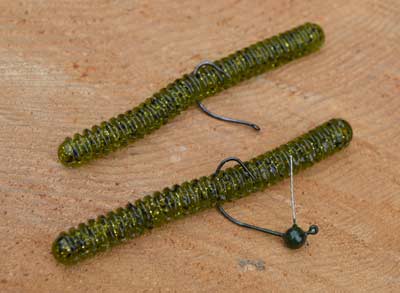
The wacky rig is deadly when bass swim around cover in shallow water. While no weight creates the best action, a weighted hook will help when bass swim slightly deeper, or wind hampers casting. Photo by Pete M. Anderson Run a hook once through a finesse worm’s middle, and its ends are free to swing as they please. That action is as natural as you can create. And without any weight, it slowly settles to the bottom, giving wary bass time to strike, even in shallow water. While a flat tail will work, a straight-tail finesse worm is best for this presentation.
Unless you possess the patience of a saint to wait for your wacky rig to sink down to the bass, you’ll want to restrict your wacky rigging to shallow water or where cover is near the surface such as floating boat docks. And that's good because that's where this presentation excels. It's perfect for skipping across the surface to reach bass tucked under overhanging cover, where they find refuge from summer's hustle and bustle.
Once you’ve placed your wacky rigged finesse worm near or under cover, let it sink on a semi-slack line. That ensures a vertical fall, keeping it right where you believe a bass swims. The bit of freedom also allows it to make the most action. Rigging yours up with this gear makes it even more potent:
- Rod: A 6-foot, 6-inch model is shorter than the typical bass rod, but it makes it easy for the underhand casts to skip these worms into tight places. Choose one with a fast action and medium power.
- Line: Fluorocarbon or monofilament — 8- or 10-pound test — has a larger diameter than similarly rated braids, making it stiffer and less likely to wedge in or wrap around cover, reducing snags.
- Hook: Rig a wide-gap and short-shank hook designed for this presentation, especially for those sporting a single-strand wire weed guard. Match its size to your worm’s thickness.
- Weight: This presentation is best fished without any additional weight. But if you need to extend your skips, beat a breeze, or get your worm deeper, a small amount — 1/32 or 1/16 — is OK.


